Heinrich J.G., Aldinger F. (Eds.) Ceramic Materials and Components for Engines
Подождите немного. Документ загружается.

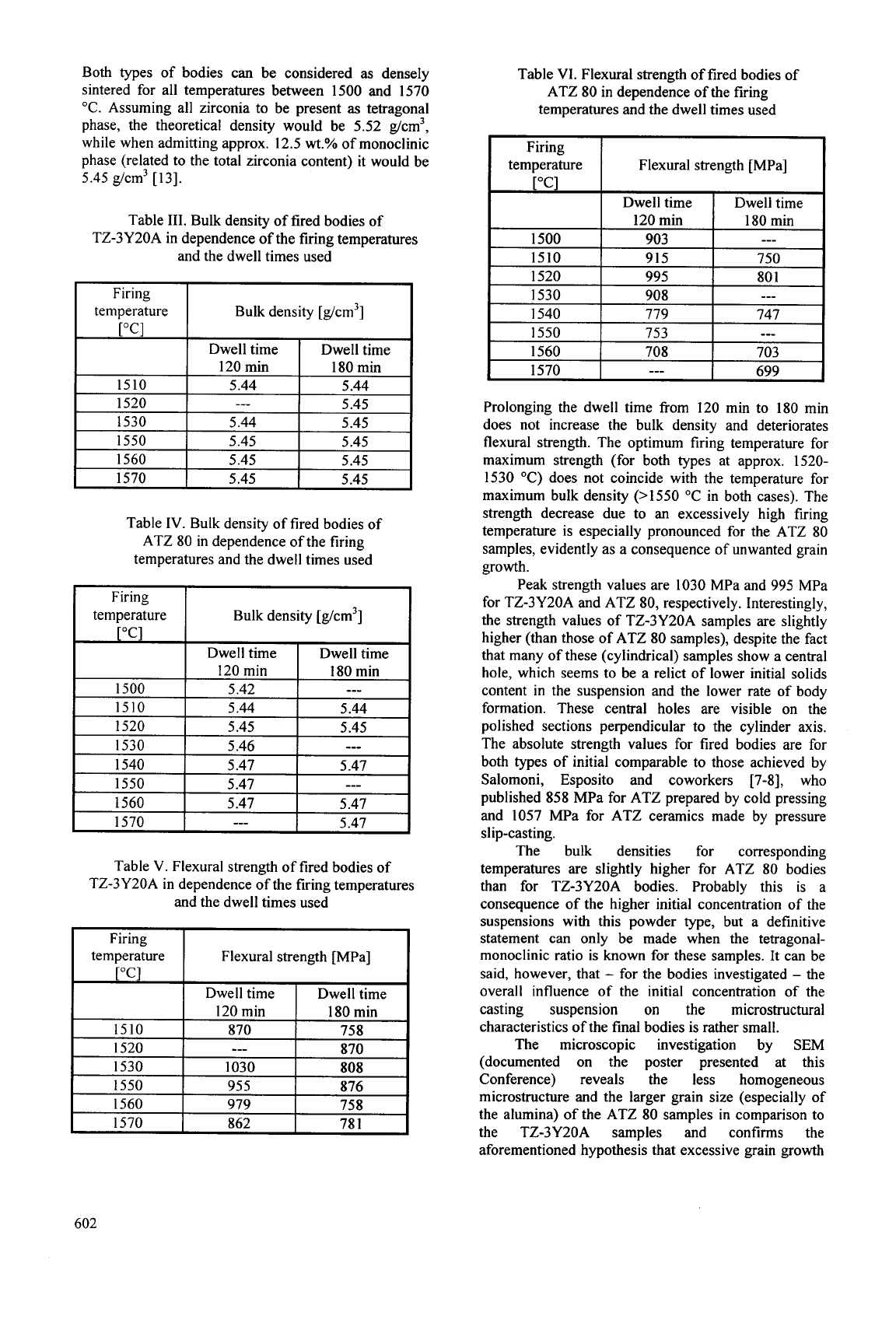
Both types of bodies can be considered as densely
sintered for all temperatures between 1500 and 1570
"C.
Assuming all zirconia to be present
as
tetragonal
phase, the theoretical density would be 5.52 g/cm3,
while when admitting approx. 12.5
wt.% of monoclinic
phase (related to the total zirconia content) it would be
5.45 g/cm3 [13].
~~
1500 903
---
1510 915 750
1520 995
xo
1
-
Table
111.
Bulk density of fired bodies of
TZ-3Y20A in dependence of the firing temperatures
and the dwell times used
1560
Firing
temperature Bulk density [g/cm']
Dwell time Dwell time
5.45
I
5.45
120 min 180 rnin
1520
1530 5.44 5.45
120 min
I
1550
I
5.45
I
5
45
I
180
min
1500
Table
IV.
Bulk density of fired bodies of
ATZ
80
in
dependence of the firing
temperatures and the dwell times used
5.42
I
-_-
Firing
I
temperature
I
Bulk density [g/cm3]
1510
1520
1530
[
"C]
I
Dwell time
I
Dwell time
-. .-
5.44 5.44
5.45 5.45
5
-46
-_-
1540
1550
-. .-
I
5.47
I
5.47
5.47
---
1560
1570
5.47 5.47
---
5.47
~~
Table
V.
Flexural strength of fired bodies of
TZ-3Y20A
in
dependence of the firing temperatures
and the dwell times used
Table
VI.
Flexural strength of fired bodies of
ATZ
80
in dependence of the firing
temperatures and the dwell times used
Firing
temperature Flexural strength [MPa]
Dwell time Dwell time
1550
1560 708 703
699
1570
---
Prolonging the dwell time from 120 min to 180 min
does not increase the bulk density and deteriorates
flexural strength. The optimum firing temperature for
maximum strength (for both types at approx. 1520-
1530
"C)
does not coincide with the temperature for
maximum bulk density (>1550
"C
in both cases). The
strength decrease due to an excessively high firing
temperature is especially pronounced for the ATZ
80
samples, evidently as a consequence of unwanted grain
growth.
Peak strength values are 1030 MPa and 995 MPa
for TZ-3Y20A and ATZ
80,
respectively. Interestingly,
the strength values of TZ-3Y20A samples are slightly
higher (than those of ATZ
80
samples), despite the fact
that many
of
these (cylindrical) samples show a central
hole, which seems to be a relict of lower initial solids
content
in
the suspension and the lower rate of body
formation. These central holes are visible on the
polished sections perpendicular to the cylinder axis.
The absolute strength values for fired bodies are for
both types of initial comparable to those achieved by
Salomoni, Esposito and coworkers
[7-81,
who
published 858 MPa for ATZ prepared by cold pressing
and 1057 MPa for ATZ ceramics made by pressure
slip-casting.
The bulk densities for corresponding
temperatures are slightly higher for ATZ
80
bodies
than for TZ-3Y20A bodies. Probably this is a
consequence of the higher initial concentration of the
suspensions with this powder type, but a definitive
statement can only be made when the tetragonal-
monoclinic ratio is known for these samples. It can be
said, however, that
-
for the bodies investigated
-
the
overall influence of the initial concentration of the
casting suspension on the microstructural
characteristics of the final bodies is rather small.
The microscopic investigation by SEM
(documented on the poster presented at this
Conference) reveals the less homogeneous
microstructure and the larger grain size (especially of
the alumina) of the ATZ
80
samples in comparison to
the TZ-3Y20A samples and confirms the
aforementioned hypothesis that excessive grain growth
602
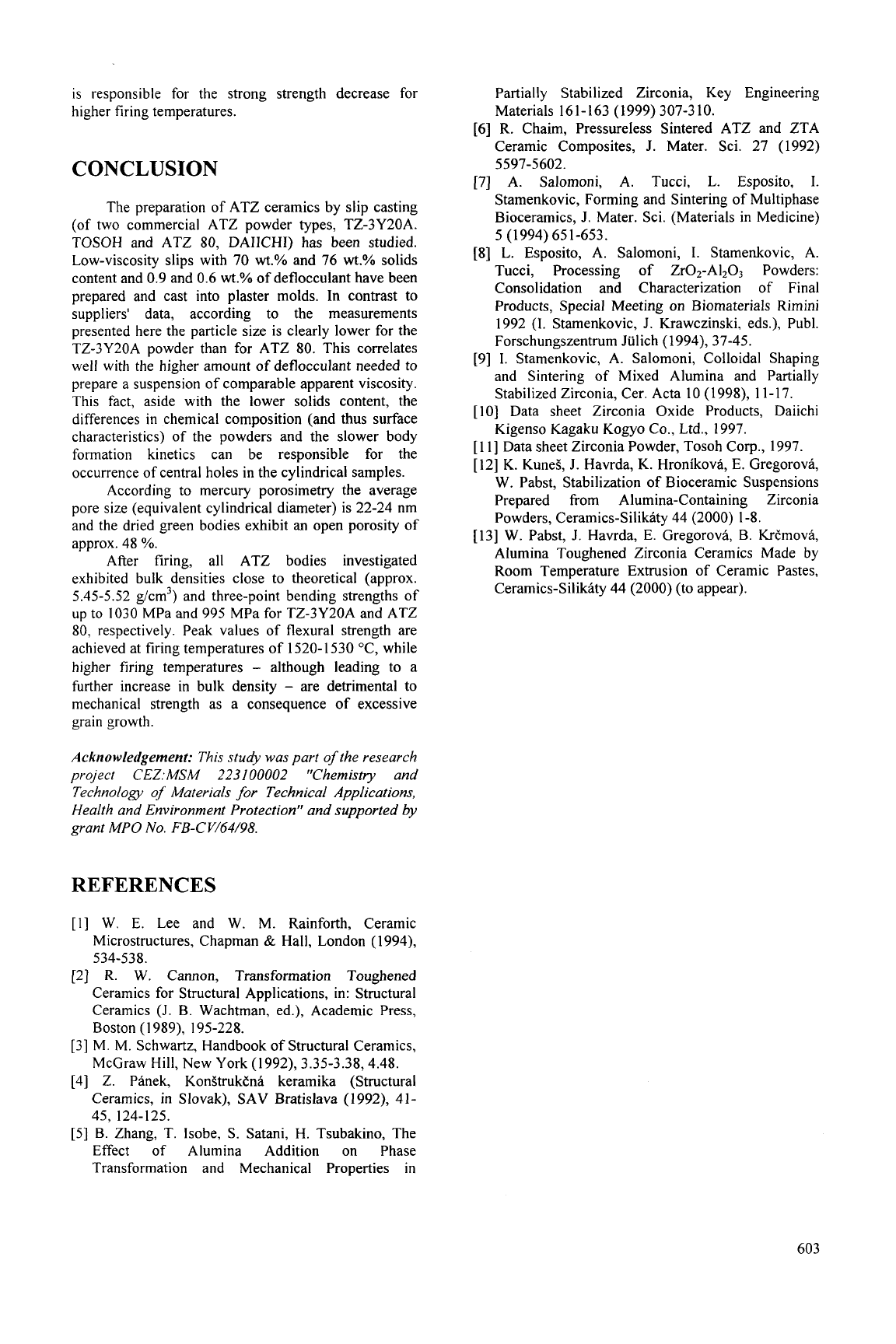
is responsible for the strong strength decrease for
higher firing temperatures.
CONCLUSION
The preparation of ATZ ceramics by slip casting
(of two commercial ATZ powder types, TZ-3Y20A.
TOSOH and ATZ
80,
DAIICHI) has been studied.
Low-viscosity slips with 70
wt.%
and 76
wt.%
solids
content and 0.9 and 0.6
wt.%
of deflocculant have been
prepared and cast into plaster molds.
In
contrast to
suppliers' data, according to the measurements
presented here the particle size is clearly lower for the
TZ-3Y20A powder than for ATZ
80.
This correlates
well with the higher amount of deflocculant needed to
prepare a suspension of comparable apparent viscosity.
This fact, aside with the lower solids content, the
differences in chemical composition (and thus surface
characteristics) of the powders and the slower body
formation kinetics can be responsible for the
occurrence of central holes in the cylindrical samples.
According to mercury porosimetry the average
pore size (equivalent cylindrical diameter) is 22-24 nm
and the dried green bodies exhibit
an
open porosity of
approx. 48
YO.
After firing, all ATZ bodies investigated
exhibited bulk densities close to theoretical (approx.
5.45-5.52 g/cm3) and three-point bending strengths of
up to 1030 MPa and
995
MPa for TZ-3Y20A and ATZ
80,
respectively. Peak values of flexural strength are
achieved at firing temperatures of 1520-1 530 "C, while
higher firing temperatures
-
although leading to a
further increase in bulk density
-
are detrimental to
mechanical strength as a consequence of excessive
grain growth.
Acknowledgement: This study was part
of
the research
project
CEZ:MSM
2231 00002 "Chemistry and
Technology
of
Materials for Technical Applications,
Health and Environment Protection" and supported
by
grant MPO
No.
FB-CV/64/98.
REFERENCES
[I]
W.
E.
Lee and
W.
M. Rainforth, Ceramic
Microstructures, Chapman
&
Hall, London (1994),
[2]
R.
W.
Cannon, Transformation Toughened
Ceramics for Structural Applications, in: Structural
Ceramics
(J.
B.
Wachtman, ed.), Academic Press,
Boston
(1
989), 195-228.
[3] M. M. Schwartz, Handbook of Structural Ceramics,
McGraw Hill, New York (1992), 3.35-3.38,4.48.
[4] Z. Panek, KonStrukEna keramika (Structural
Ceramics,
in
Slovak), SAV Bratislava
(1
992), 4
1
-
[5]
B.
Zhang, T. Isobe,
S.
Satani,
H.
Tsubakino, The
Effect of Alumina Addition on Phase
Transformation and Mechanical Properties in
534-538.
45, 124-125.
Partially Stabilized Zirconia, Key Engineering
Materials
16
1
-
163 (1999) 307-3
10.
[6]
R.
Chaim, Pressureless Sintered ATZ and ZTA
Ceramic Composites, J. Mater. Sci. 27 (1992)
[7] A. Salomoni,
A.
Tucci, L. Esposito,
I.
Stamenkovic, Forming and Sintering of Multiphase
Bioceramics, J. Mater. Sci. (Materials in Medicine)
[8]
L. Esposito, A. Salomoni,
I.
Stamenkovic, A.
Tucci, Processing
of
Zr02-A1203 Powders:
Consolidation and Characterization of Final
Products, Special Meeting on Biomaterials Rimini
1992
(I.
Stamenkovic,
J.
Krawczinski, eds.), Publ.
Forschungszentrum Jiilich (1994), 37-45.
[9]
I.
Stamenkovic, A. Salomoni, Colloidal Shaping
and Sintering of Mixed Alumina and Partially
Stabilized Zirconia, Cer. Acta
10
(1998), 11-17.
[
101
Data sheet Zirconia Oxide Products, Daiichi
Kigenso Kagaku Kogyo Co., Ltd., 1997.
[I
I] Data sheet Zirconia Powder, Tosoh Corp., 1997.
[12] K. KuneS,
J.
Havrda,
K.
Hronikova,
E.
Gregorova,
W.
Pabst, Stabilization of Bioceramic Suspensions
Prepared
from
Alumina-Containing Zirconia
Powders, Ceramics-Silikaty 44 (2000)
1-8.
[I31
W.
Pabst,
J.
Havrda, E. Gregorova,
B.
KrEmova,
Alumina Toughened Zirconia Ceramics Made by
Room Temperature Extrusion of Ceramic Pastes,
Ceramics-Silikaty
44
(2000) (to appear).
5
597-5 602.
5
(1994) 651-653.
603

This Page Intentionally Left Blank
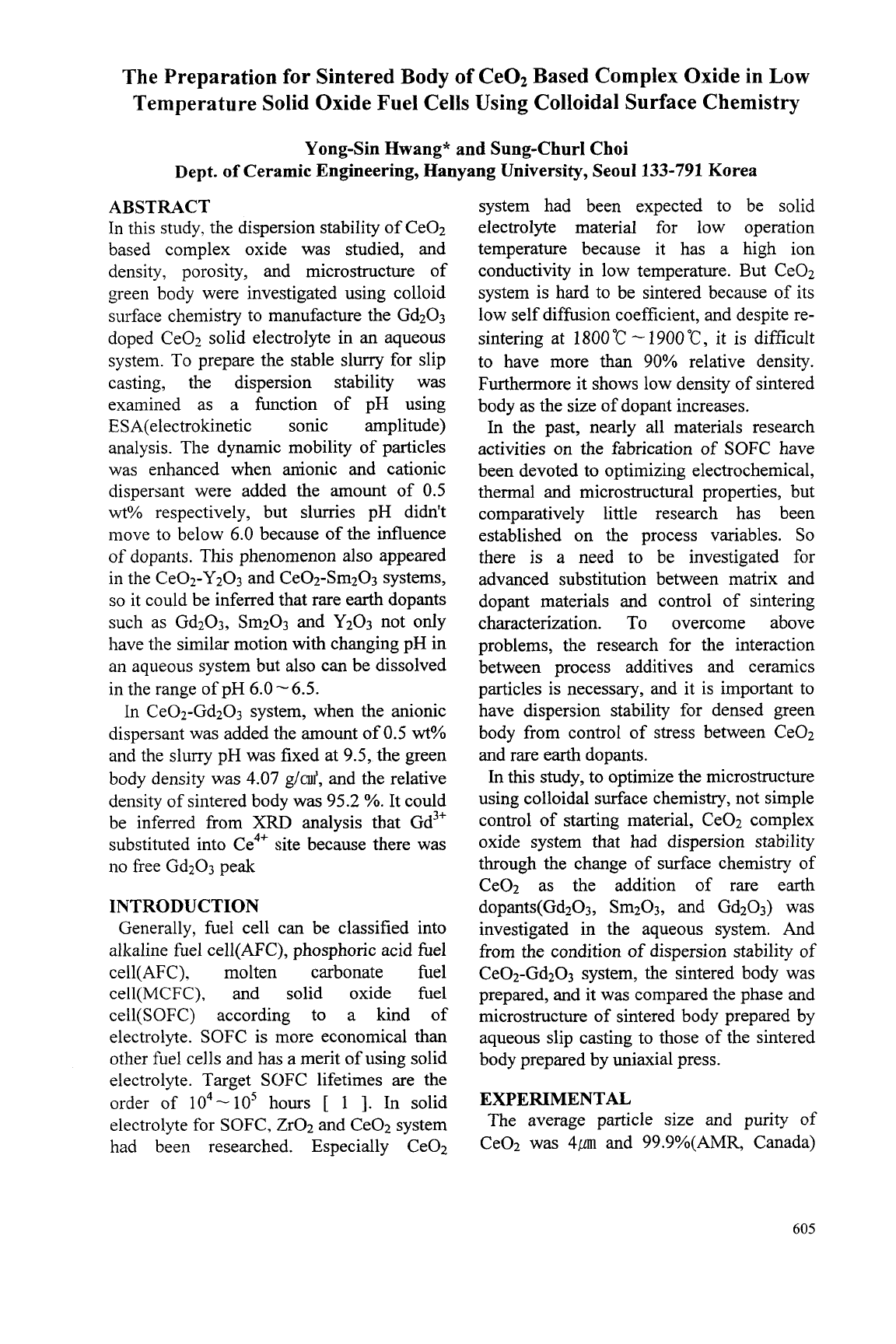
The Preparation for Sintered Body
of
Ce02 Based Complex Oxide in
Low
Temperature Solid Oxide Fuel Cells Using Colloidal Surface Chemistry
Yong-Sin Hwang* and Sung-Churl Choi
Dept.
of
Ceramic Engineering, Hanyang University, Seoul
133-791
Korea
ABSTRACT
In this study. the dispersion stability
of
Ce02
based complex oxide was studied, and
density, porosity, and microstructure of
green body were investigated using colloid
surface chemistry to manufacture the Gd2O3
doped CeOz solid electrolyte in an aqueous
system. To prepare the stable slurry for slip
casting, the dispersion stability was
examined as a function of pH using
ESA(e1ectrokinetic sonic amplitude)
analysis. The dynamic mobility
of
particles
was enhanced when anionic and cationic
dispersant were added the amount of
0.5
wt% respectively, but slurries pH didn't
move to below
6.0 because of the influence
of
dopants. This phenomenon also appeared
in
the Ce02-Y203 and Ce02-Sm203 systems,
so
it could be inferred that rare earth dopants
such as Gd2O3, SrnzO3 and Y2O3 not only
have the similar motion with changing pH in
an aqueous system but also can be dissolved
in the range
of
pH
6.0
-6.5.
In Ce02-Gd203 system, when the anionic
dispersant was added the amount of 0.5
wt%
and the slurry pH was fixed at 9.5, the green
body density was
4.07
g/d,
and the relative
density
of
sintered body was 95.2
YO.
It could
be inferred from
XRD
analysis that Gd3'
substituted into Ce4+ site because there was
no free Gd2O3 peak
INTRODUCTION
Generally, ftiel cell can be classified into
alkaline fuel cell(AFC), phosphoric acid fuel
cell(AFC), molten carbonate fuel
cell(MCFC), and solid oxide
fuel
cell(S0FC) according to a kind
of
electrolyte. SOFC is more economical than
other fuel cells and has a merit of using solid
electrolyte. Target SOFC lifetimes are the
order
of
lo4
-
10'
hours
[
1
1.
In solid
electrolyte for SOFC,
21-02
and CeO2 system
had been researched. Especially CeO2
system had been expected to be solid
electrolyte material for low operation
temperature because it has a high ion
conductivity in low temperature. But Ce02
system is hard to be sintered because
of its
low self diffusion coefficient, and despite re-
sintering at 1800
"c
-
1900
C,
it is difficult
to have more than
90%
relative density.
Furthermore it shows low density of sintered
body as the size
of
dopant increases.
In
the past, nearly all materials research
activities on the fabrication of SOFC have
been devoted to optimizing electrochemical,
thermal and microstructural properties, but
comparatively little research has been
established on the process variables.
So
there is a need to be investigated for
advanced substitution between matrix and
dopant materials and control of sintering
characterization.
To
overcome above
problems, the research for the interaction
between process additives and ceramics
particles is necessary, and it is important to
have dispersion stability for densed green
body from control of stress between CeO2
and rare earth dopants.
In this study, to optimize the microstructure
using colloidal surface chemistry, not simple
control of starting material, Ce02 complex
oxide system that had dispersion stability
through the change of surface chemistry of
CeO2 as the addition of rare earth
dopants(Gd203, Sm203, and Gd2O3) was
investigated in the aqueous system. And
from the condition of dispersion stability of
CeO2-GdzO3 system, the sintered body was
prepared, and it was compared the phase and
microstructure of sintered body prepared by
aqueous slip casting to those of the sintered
body prepared by uniaxial press.
EXPERIMENTAL
The average particle size and purity of
CeO2 was
4pm
and 99.9%(AMR, Canada)
605
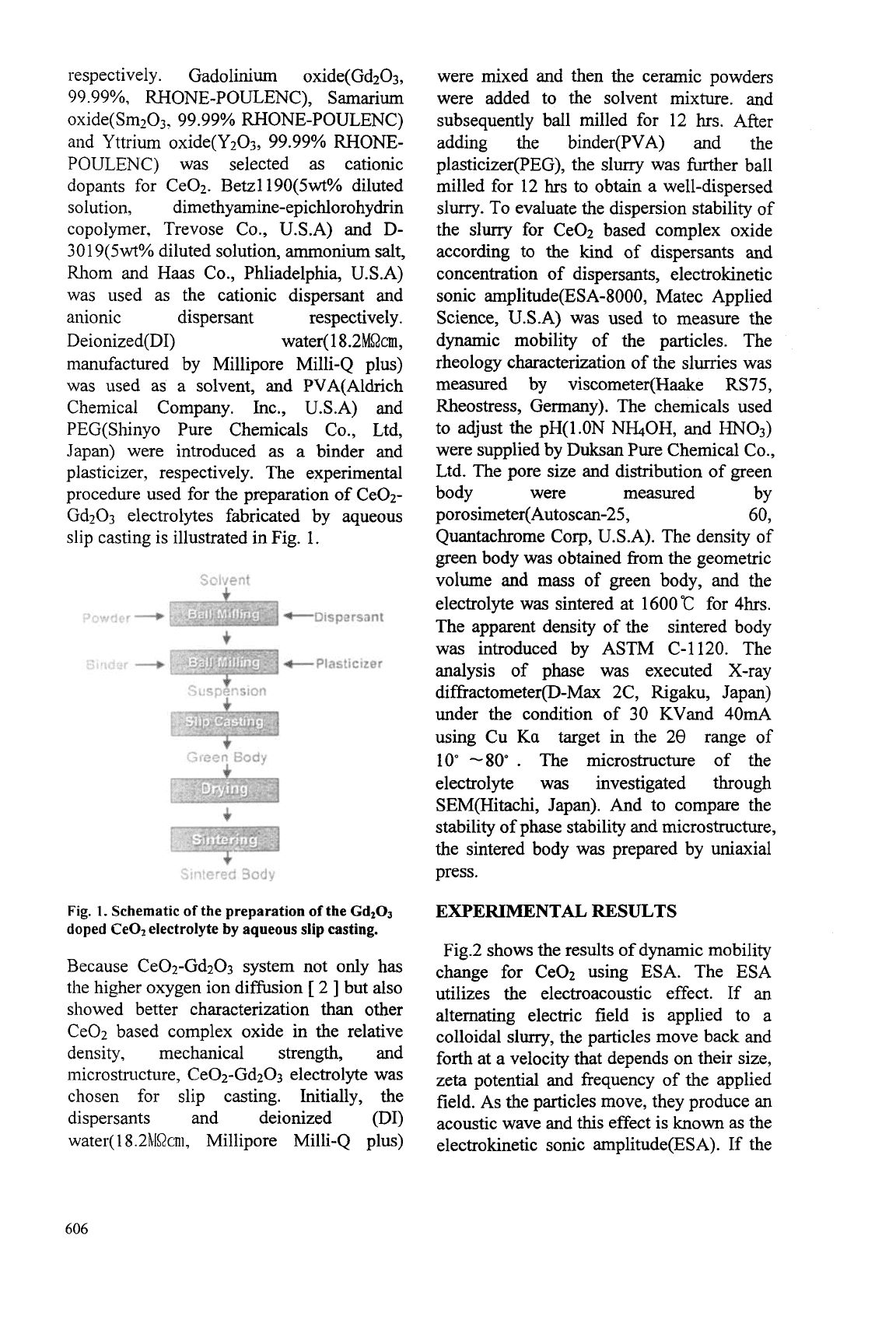
respectively. Gadolinium oxide(Gd203,
99.99%, NONE-POULENC), Samarium
oxide( Sm103, 99.99% RHONE-POULENC)
and Yttrium oxide(Y203, 99.99%
RHONE-
POULENC)
was selected
as
cationic
dopants for CeO2. Betzl190(5wt% diluted
solution,
dimethyamine-epichlorohydrin
copolymer, Trevose
Co.,
U.S.A) and D-
301 9(5wt% diluted solution, ammonium salt,
Rhom and Haas Co., Phliadelphia, USA)
was used as the cationic dispersant and
anionic dispersant respectively.
Deionized(D1) water( 18.2MsZcm,
manufactured by Millipore Milli-Q plus)
was used as a solvent, and PVA(A1drich
Chemical Company. Inc., U.S.A) and
PEG(S1iinyo Pure Chemicals
Co.,
Ltd,
Japan) were introduced as a binder and
plasticizer, respectively. The experimental
procedure used for the preparation of CeOz-
Gd203 electrolytes fabricated by aqueous
slip casting is illustrated in Fig. 1.
Solvent
Powder
+
+Dispersant
Green
Body
&
7----
Sintered
Body
Fig.
1.
Schematic
of
the preparation
of
the
GdlOJ
doped CeOl electrolyte by aqueous
slip
casting.
Because Ce02-Gd203 system not only has
the higher oxygen ion diffusion
[
2
3
but also
showed better characterization than other
Ce02 based complex oxide in the relative
density, mechanical strength, and
microstructure, Ce02-Gd203 electrolyte was
chosen
for
slip casting. Initially, the
dispersants and deionized (DI)
water(
18.2h.IsZcm,
Millipore Milli-Q plus)
were mixed and then the ceramic powders
were added to the solvent mixture. and
subsequently ball milled for 12
hrs.
After
adding the binder(PVA) and the
plasticizer(PEG), the sluny was further ball
milled for 12 hrs to obtain
a
well-dispersed
slurry. To evaluate the dispersion stability of
the slurry for Ce02 based complex oxide
according to the kind
of
dispersants and
concentration
of
dispersants, electrokinetic
sonic amplitude(ESA-8000, Matec Applied
Science,
U.S.A)
was used to measure the
dynamic mobility of the particles. The
rheology characterization of the slurries was
measured by viscometer(Haake
RS75,
Rheostress, Germany). The chemicals used
to adjust the pH(l.ON N&OH, and
HNO3)
were supplied by Duksan Pure Chemical
Co.,
Ltd. The pore size and distribution of green
body were measured by
porosimeter(Autoscan-25,
60,
Quantachrome
Corp,
USA). The density of
green body was obtained from the geometric
volume and mass
of
green body, and
the
electrolyte was sintered at 1600°C for
4hrs.
The apparent density of the sintered body
was introduced by ASTM C-1120. The
analysis of phase was executed X-ray
diffractometerp-Max 2C, Rigaku, Japan)
under the condition of
30
KVand
40mA
using Cu Ka target
in
the
28
range of
10" -80"
.
The microstructure of the
electrolyte was investigated through
SEM(Hitachi, Japan). And to compare the
stability
of
phase stability and microstructure,
the sintered body was prepared by uniaxial
press.
EXPERIMENTAL RESULTS
Fig.2 shows the results
of
dynamic mobility
change for Ce02 using ESA. The ESA
utilizes the electroacoustic effect. If an
alternating electric field is applied to a
colloidal
slurry,
the particles move back and
forth at a velocity that depends on their size,
zeta potential and frequency of the applied
field. As the particles move, they produce an
acoustic wave and
this
effect is
known
as the
electrokinetic sonic amplitude(ESA). If the
606
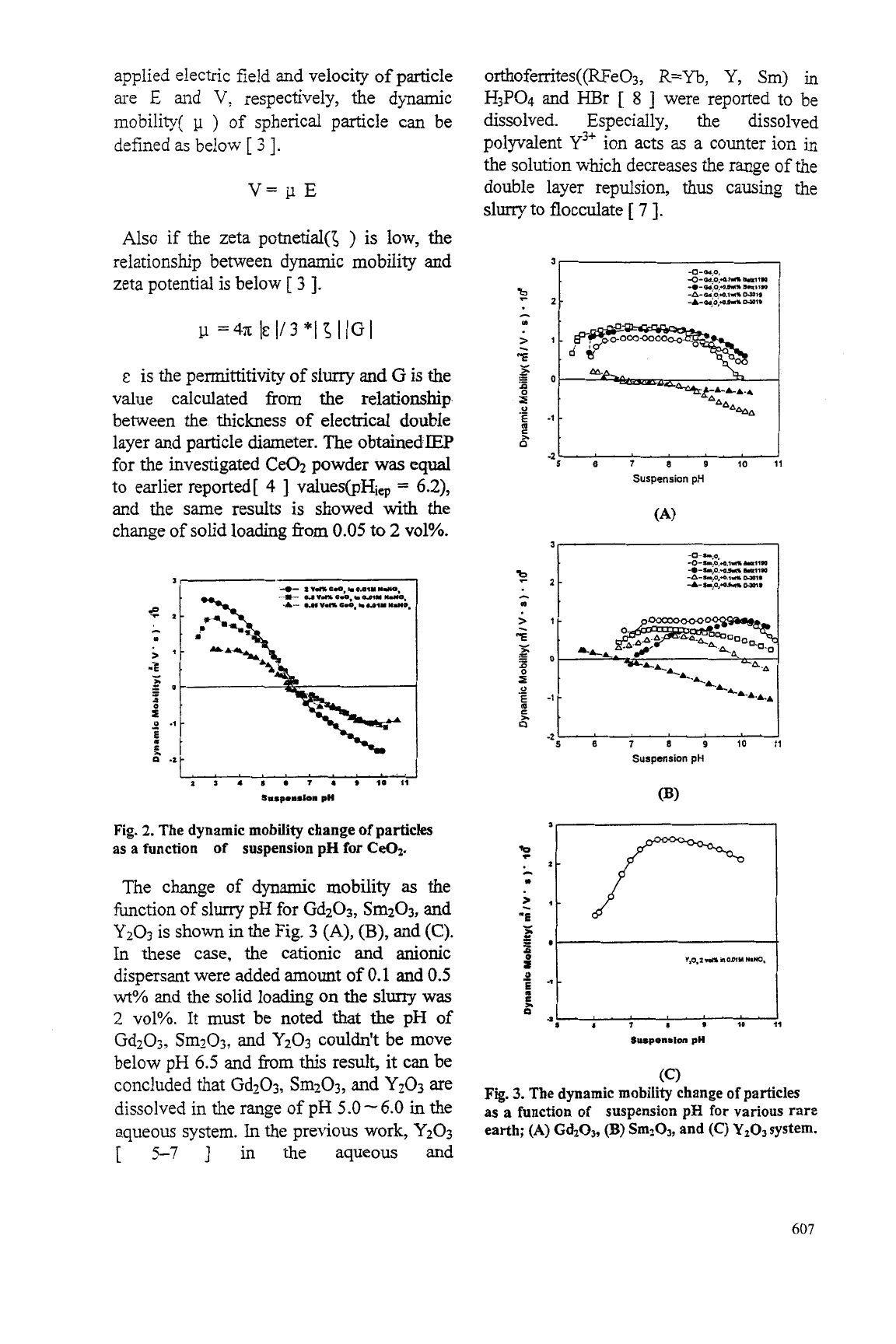
applied electric field and velocity of particle
are
E
and
V,
respectively, the dynamic
mobility(
p
)
of
spherical particle can be
defined
as
belou-
[
3
1.
V=
p
E
Also
if the zeta potnetid(<
)
is low, the
relationship between dynamic mobility and
zeta potential is below
[
3
1.
E
is the permittitivity
of
slurry and G is the
value calculated from the relationship
between the thickness
of
electrical double
layer and particle diameter. The obtainedlEP
for the investigated Ce02 powder was equal
to earlier reported[
4
3
values(pH.i,p
=
6.2),
and the same results is showed
with
the
change of solid loading
from
0.05
to
2
~01%.
1
I4
0
7
a
)loll
s.rP..rIo.
pn
Fig.
2.
The dynamic mobility change of particles
as a function of suspension pH for
CeO2.
The change
of
dynamic mobility
as
the
function of slurry pH for Gd203,
Sm2O3,
and
Y203
is
shown
in
the Fig.
3
(A),
(B), and
(C).
In
these case, the cationic and anionic
dispersant were added amount
of 0.1 and
0.5
wt%
and the solid loading
on
the sluny was
2 ~01%. It
must
be noted
that
the
pH
of
GdzOj,
SmlO;,
and
Y203
couldn’t be move
below
pH
6.5
and
from
this
result,
it
can
be
concluded that Gd203- Sm2O3, and
YzO3
are
dissolved in the range of pH
5.0
-
6.0
in
the
aqueous
system.
In
the previous work,
Y203
[
5-7
]
in the aqueous and
orthofenites((RFe03,
R=Yb,
Y,
Sm)
in
H3PO4
and HBr
[
8
]
were reported to be
dissolved. Especially, the dissolved
polyvalent
Y”
ion acts
as
a counter ion in
the solution which decreases the range
of
the
double layer repulsion, thus causing the
slurry to flocculate
[
7
1.
5
6
7
a
9
io
11
Suspension
pH
-2
‘
(A)
m
5678910
-2
I
Suspension
pH
“E
r
11
1
Suspension
PH
(C)
Fig.
3.
The dynamic mobility change
of
particles
as
a function
of
suspension pH for
various
rare
earth;
(A)
Gd203,
(B)
Sm203,
and
(C)
Y203
system.
607
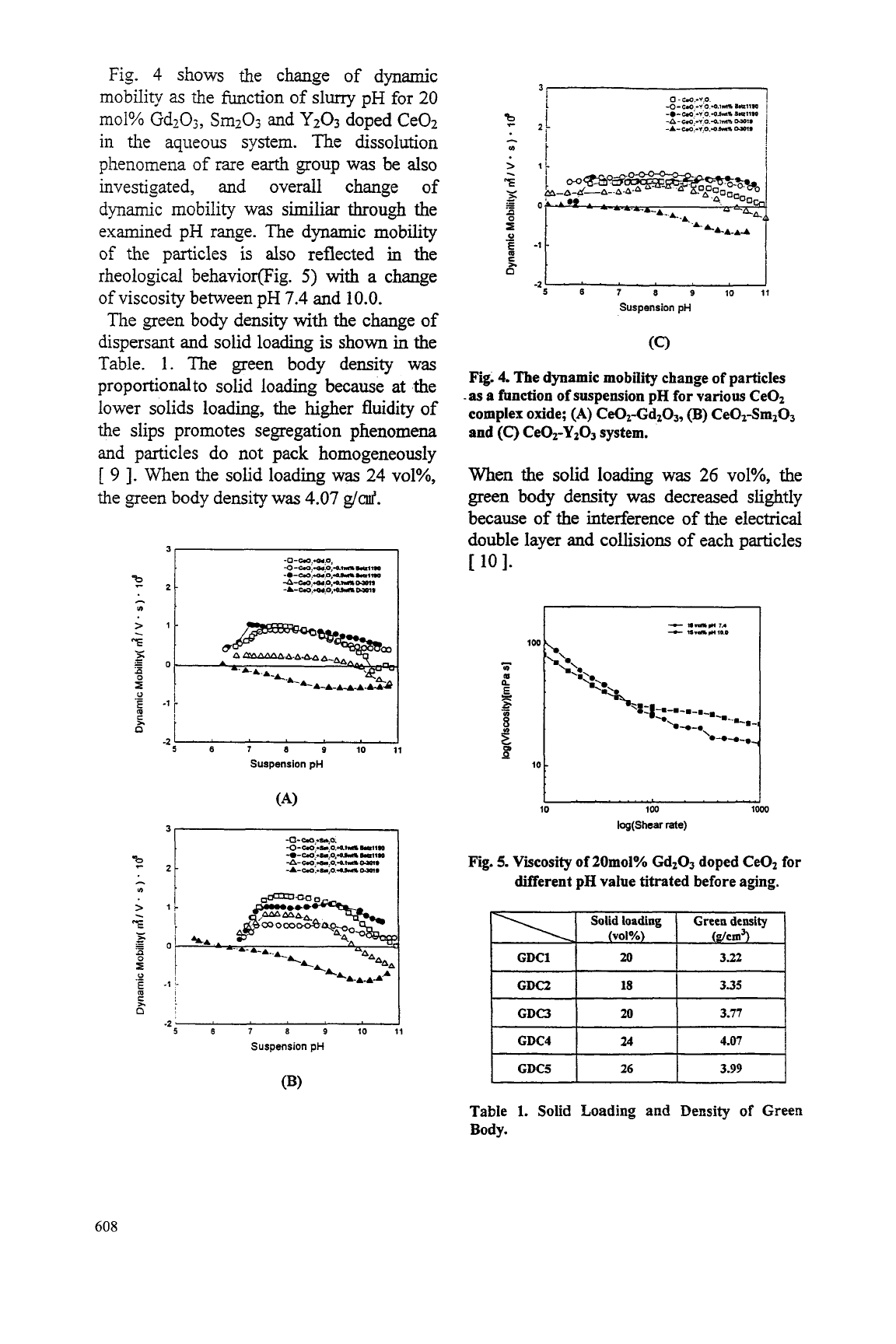
Fig.
4
shows the change of dynamic
mobility
as
the function of slurry pH for
20
mol%
GdlO;,
SmlO;
and
Y203
doped Ce02
in
the aqueous system. The dissolution
plienoineiia
of
rare earth group
was
be
also
investigated, and overall change of
dynamic
mobility
was
similiar
through
the
examined pH range. The dynamic mobility
of
the particles is also reflected
in
the
rheological behaviorpig.
5)
with a change
of
viscosity between pH
7.4
and
10.0.
The
green body density
with
the change
of
dispersant
and
solid loading
is
shown
in
the
Table.
1.
The green body density
was
proportionalto
solid
loading
because at the
lower solids loading, the higher fluidity
of
the
slips promotes segregation phenomena
and
particles do not pack homogeneously
[
9
1.
When the
solid
loading
was
24
vol%,
the green
body
density
was
4.07
g/d.
Solid loading
(vole/)
GDCl 20
J
5
6
7
8
9
10
11
Suspension pH
Green
density
(dcrn3
3.22
-2
;
5 6
7
8
9
10
11
Suspension
pH
GDC2
GDQ
5676910
Suspension
pH
18 3.35
20
3.77
I
GDC5
Fig.
4.
The dynamic mobility change of particles
-as
a
function of suspension pH for various CeOz
complex oxide;
(A)
CeOz-Gd2O3,
(B)
CeO2-SmZO3
and
(C)
Ce02-Y203
system.
26
3.99
When the solid loading
was
26
vol%,
the
green body density
was
decreased
slightly
because
of
the interference
of
the electrical
double layer
and
collisions
of
each particles
10
I.
I
10
100
log(Shsar
rate)
x)
Fig.
5.
Viscosity
of
20moI% Gd2@ doped CeOZ for
different pH value titrated before aging.
I
GDC4
I
24
1
4.07
1
Table
1.
Solid Loading
and
Density
of
Green
Body.
608
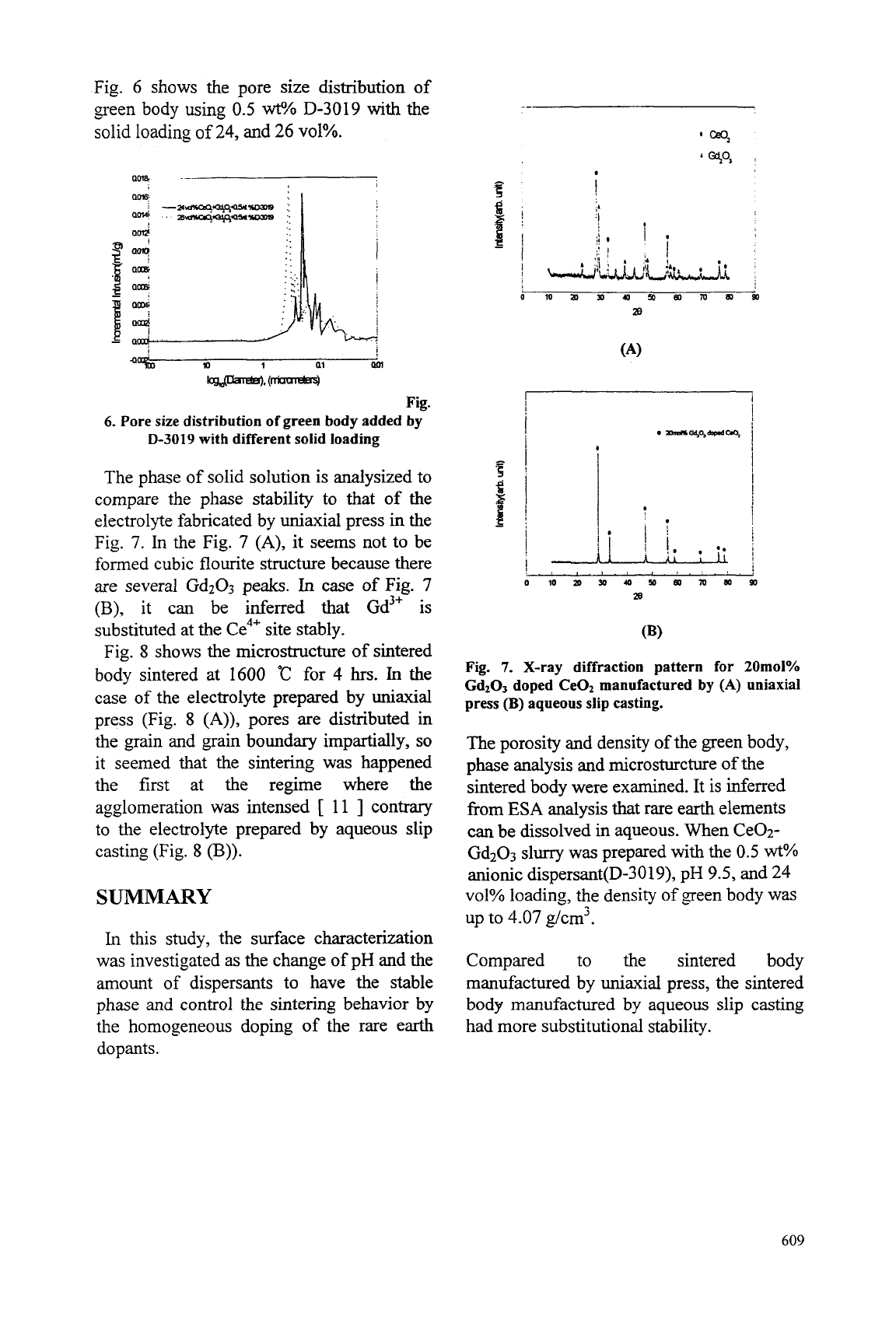
Fig.
6
shows the pore size distribution of
*
seen body using
0.5
wt?h
D-3019 with the
solid loading of
24,
and
26
~01%.
a?
a?
:
--Id%Qf&q--
.-
!b;;
a$
am
i
0%
'
t*q*.5lt-
1:
z...:
.
.:_
.
-:
z-
..
..
1:
..
.
..
!
-
a
!..
...
!
j
IC400.
(rmcnetes)
6.
Pore size distribution of green body added by
D-3019
with different solid loading
lo
1
a1
Qol
Fig.
The phase
of
solid solution is analysized to
compare the phase stability to that
of
the
electrolyte fabricated by uniaxial press
in
the
Fig.
7.
In the Fig.
7
(A), it seems
not
to be
formed cubic flourite structure because there
are several
Gd203
peaks.
In
case
of
Fig.
7
(B),
it can be inferred that Gd3'
is
substituted at the Ce4' site stably.
Fig.
8
shows the microstructure of sintered
body sintered at
1600
"c
for
4
hrs.
In the
case
of
the electrolyte prepared
by
uniaxial
press (Fig.
8
(A)),
pores are distributed in
the grain and grain boundary impartially,
so
it seemed that the sintering was happened
the first at the regime where the
agglomeration was intensed
[
11
]
contrary
to the electrolyte prepared by aqueous slip
casting (Fig.
8
(B)).
SUMMARY
In
this study, the surface characterization
was investigated as the change of pH and the
amount
of
dispersants to have the stable
phase
and
control the sintering behavior by
the homogeneous doping
of
the rare earth
dopants.
Fig.
7.
X-ray diffraction pattern
for
20mol%
Gd203 doped CeOz manufactured by
(A)
uniaxial
press
(B)
aqueous slip casting.
The
porosity and density
of
the green body,
phase analysis and microsturcture
of
the
sintered body were examined. It is inferred
from
ESA
analysis that rare earth elements
can be dissolved
in
aqueous. When CeOz-
GdzO3 slurry was prepared with the
0.5
wtYo
anionic dispersant(D-3019), pH
9.5,
and
24
vol% loading, the density of green body was
up to
4.07
g/cm3.
Compared to the sintered body
manufactured by
uniaxial
press, the sintered
body
manufactured by aqueous slip casting
had more substitutional stability.
609
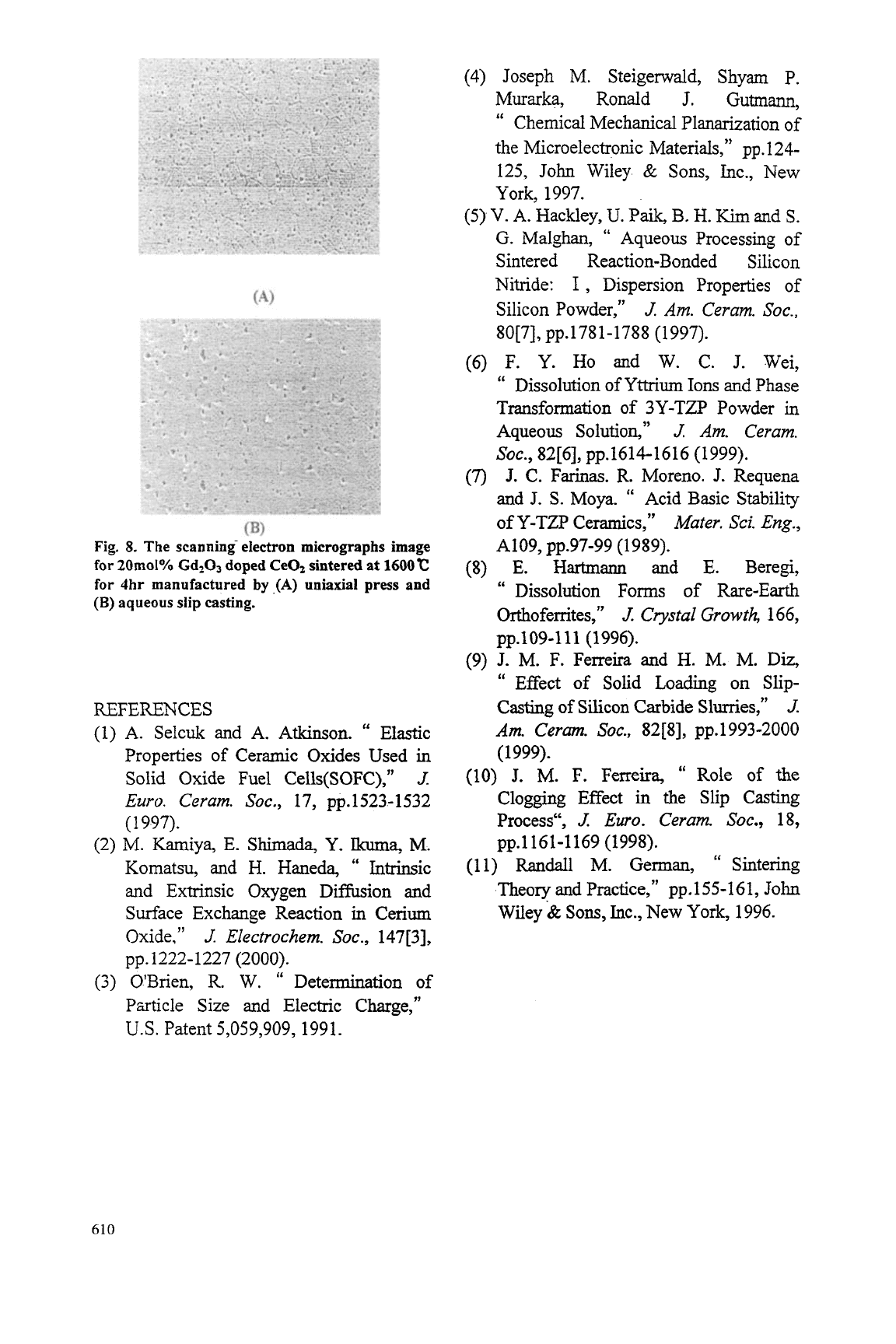
(B)
Fig.
8.
The scanning electron micrographs image
for
20mol%
Gd103 doped
CeOt
sintered at
1600c
for Jhr manufactured
by
,(A)
uniaxial press and
(B)
aqueous
slip
casting.
REFERENCES
A. Selcuk and
A.
Atkinson.
"
Elastic
Properties
of
Ceramic
Oxides
Used in
Solid Oxide Fuel Cells(SOFC),"
J.
Euro.
Ceram.
SOC.,
17, pp.1523-1532
(1
997).
M.
Kamiya, E. Shimada, Y.
ha,
M.
Komatsu, and
H.
Haneda,
"
Intrinsic
and Extrinsic Oxygen Diffusion and
Surface Exchange Reaction
in Cerium
Oxide,"
J
Electrochem.
SOC.,
147[3],
O'Brien,
R.
W.
"
Determination
of
Psrticle Size and Electric Charge,"
U.S.
Patent
5,059,909, 1991.
pp.
1222-1227 (2000).
(4)
(5)
Joseph
M.
Steigerwald, Shyam
P.
Murarka,
Ronald
J.
Gutmann,
"
Chemical Mechanical Planarization of
the Microelectronk Materials,"
pp. 124-
125,
John Wiley
&
Sons,
Inc., New
York,
1997.
V.
A.
Hackley,
TJ.
Pa&
B.
H.
Kim
and
S.
G.
Malghan,
"
Aqueous Processing of
Sintered Reaction-Bonded Silicon
Nitride:
I
,
Dispersion Properties
of
Silicon Powder,"
J.
Am.
Ceram.
Suc.,
80[7], pp. 178 1-1788 (1 997).
(6)
F.
Y.
HO
and
W.
C.
J.
Wei,
"
Dissolution
of
Yttrium
Ions
and Phase
Transformation
of
3Y-TZP
Powder
in
Aqueous Solution,"
J
Am.
Ceram.
('7)
J.
C. Farhas.
R.
Moreno.
J.
Requena
and
J.
S.
Moya.
"
Acid Basic Stability
of
Y-TZP Ceramics,"
Mater.
Sci.
Eng.,
(8)
E.
Hartmann
and
E.
Beregi,
"
Dissolution
Forms
of Rare-Earth
Orthofemtes,"
J.
Crystal Growth,
166,
(9)
J.
M.
F.
Ferreira and
H.
M.
M.
Diz,
"
Effect
of
Solid
Loading on Slip-
Casting
of
Silicon Carbide Slurries,"
J.
Am.
Ceram.
Soc.,
82[8], pp.1993-2000
(10)
J.
M.
F.
Ferreira,
"
Role
of
the
Clogging Effect in the Slip Casting
Process",
.I
EWO.
Ceram.
SOC.,
18,
(11)
Randall
M.
German,
"
Sintering
Theory and Practice,"
pp.155-161,
John
Wiley
&
Sons,
Inc., New York,
1996.
SOC.,
82[6], pp.1614-1616 (1999).
A109, pp.97-99 (1989).
pp.109-111 (1996).
(1 999).
pp.1161-1169 (1998).
610
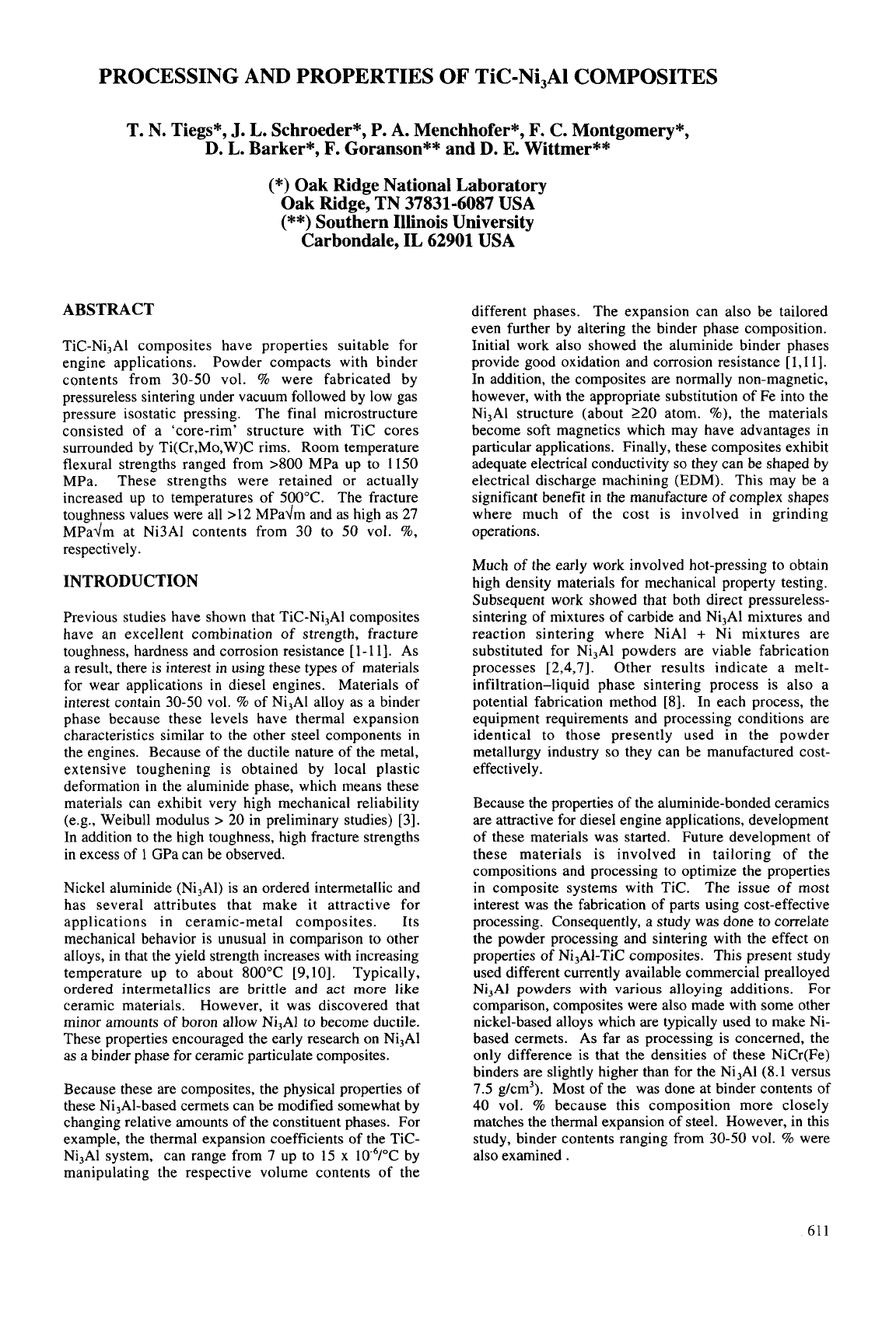
PROCESSING AND PROPERTIES
OF
Tic-Ni,Al COMPOSITES
T.
N.
Tiegs*,
J.
L.
Schroeder",
P.
A.
Menchhofer",
F.
C.
Montgomery*,
D.
L. Barker*,
F.
Goranson** and
D.
E.
Wittmer**
(*)
Oak Ridge National Laboratory
Oak Ridge, TN 37831-6087
USA
(**)
Southern Illinois University
Carbondale, IL 62901
USA
ABSTRACT
Tic-Ni,AI composites have properties suitable for
engine applications. Powder compacts with binder
contents from 30-50 vol.
%
were fabricated by
pressureless sintering under vacuum followed by low gas
pressure isostatic pressing. The final microstructure
consisted of a 'core-rim' structure with Tic cores
surrounded by Ti(Cr,Mo,W)C rims. Room temperature
flexural strengths ranged from
SO0
MPa up to 1150
MPa. These strengths were retained or actually
increased up to temperatures of 500°C. The fracture
toughness values were all >12 MPadm and as high as 27
MPadm at Ni3Al contents from 30 to
50
vol.
%,
respectively.
INTRODUCTION
Previous studies have shown that Tic-Ni,AI composites
have an excellent combination of strength, fracture
toughness, hardness and corrosion resistance
[
1-1
11.
As
a result, there is interest
in
using these types of materials
for wear applications
in
diesel engines. Materials of
interest contain 30-50 vol.
%
of Ni,Al alloy as a binder
phase because these levels have thermal expansion
characteristics similar to the other steel components
in
the engines. Because of the ductile nature of the metal,
extensive toughening is obtained by local plastic
deformation
in
the aluminide phase, which means these
materials can exhibit very high mechanical reliability
(e.g., Weibull modulus
>
20 in preliminary studies) [3].
In addition to the high toughness, high fracture strengths
in
excess of
1
GPa can be observed.
Nickel aluminide (Ni,Al) is an ordered intermetallic and
has several attributes that make it attractive for
applications in ceramic-metal composites. Its
mechanical behavior is unusual in comparison to other
alloys, in that the yield strength increases with increasing
temperature up to about 800°C
[9,10].
Typically,
ordered intermetallics are brittle and act more like
ceramic materials. However, it was discovered that
minor amounts of boron allow Ni,Al to become ductile.
These properties encouraged the early research on Ni,Al
as
a binder phase for ceramic particulate composites.
Because these are composites, the physical properties of
these Ni,Al-based cermets can be modified somewhat by
changing relative amounts of the constituent phases. For
example, the thermal expansion coefficients of the TiC-
Ni,Al system, can range from
7
up to
15
x 10-6/oC by
manipulating the respective volume contents of the
different phases. The expansion can also be tailored
even further by altering the binder phase composition.
Initial work also showed the aluminide binder phases
provide good oxidation and corrosion resistance
[1,11].
In addition, the composites are normally non-magnetic,
however, with the appropriate substitution of
Fe
into the
Ni,AI structure (about 220 atom.
%),
the materials
become soft magnetics which may have advantages in
particular applications. Finally, these composites exhibit
adequate electrical conductivity
so
they can be shaped by
electrical discharge machining (EDM). This may be a
significant benefit
in
the manufacture of complex shapes
where much of the cost is involved in grinding
operations.
Much of the early work involved hot-pressing to obtain
high density materials for mechanical property testing.
Subsequent work showed that both direct pressureless-
sintering of mixtures of carbide and Ni,Al mixtures and
reaction sintering where NiAl
+
Ni mixtures are
substituted for Ni,Al powders are viable fabrication
processes [2,4,7]. Other results indicate a melt-
infiltration-liquid phase sintering process is also a
potential fabrication method
[8].
In each process, the
equipment requirements and processing conditions are
identical to those presently used in the powder
metallurgy industry
so
they can be manufactured cost-
effectively.
Because the properties of the aluminide-bonded ceramics
are attractive for diesel engine applications, development
of these materials was started. Future development of
these materials is involved in tailoring of the
compositions and processing to optimize the properties
in composite systems with Tic. The issue of most
interest was the fabrication of parts using cost-effective
processing. Consequently, a study was done to correlate
the powder processing and sintering with the effect on
properties of Ni,Al-Tic composites. This present study
used different currently available commercial prealloyed
Ni,AI powders with various alloying additions. For
comparison, composites were also made with some other
nickel-based alloys which are typically used to make Ni-
based cermets. As far as processing is concerned, the
only difference is that the densities of these NiCr(Fe)
binders are slightly higher than for the Ni,AI (8.1 versus
7.5 g/cm3). Most of the was done at binder contents of
40 vol.
%
because this composition more closely
matches the thermal expansion of steel. However,
in
this
study, binder contents ranging from 30-50 vol.
%
were
also examined
.
611
